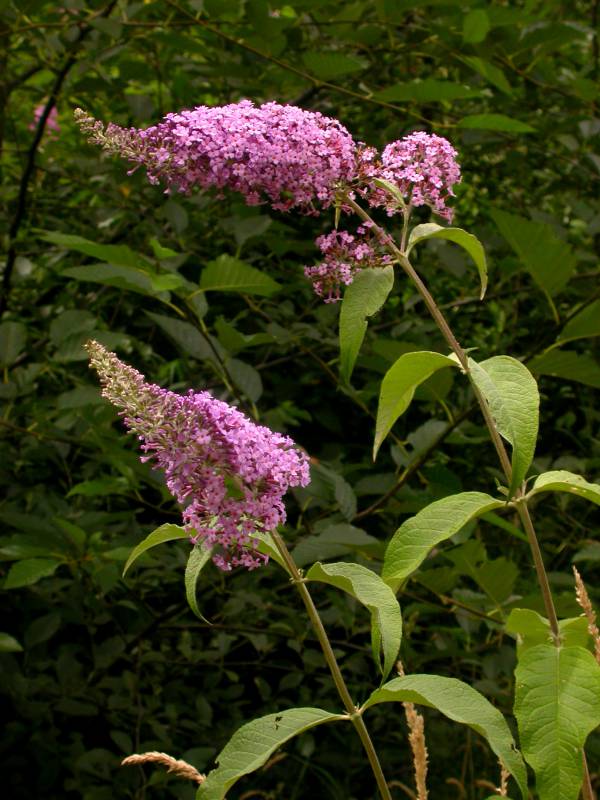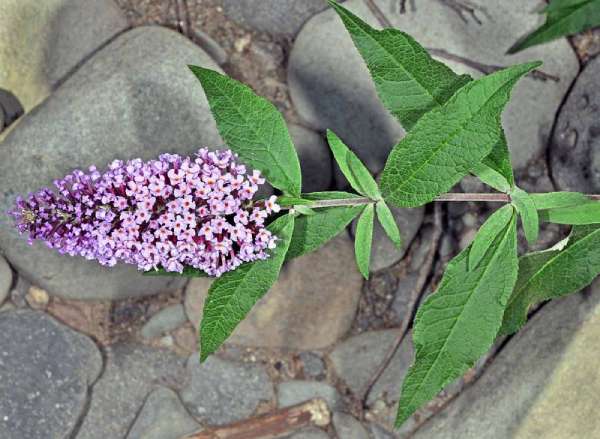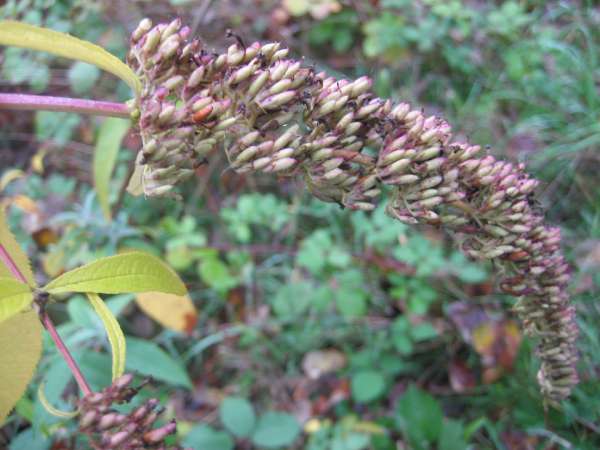Butterfly bush identification and control
About this weed
Butterfly bush is a non-regulated Class B noxious weed. This means due to how widespread it is in King County, property owners are not required to control this species on their property, though it is always encouraged.
Butterfly bush is also on the Washington quarantine list and it is illegal to buy, sell or offer it for sale in the state.
Butterfly bush is known as Buddleja davidii and it is in the figwort family. Sometimes the genus is spelled Buddleia. Additional common names include orange-eye butterfly bush and summer lilac.

Why it’s a problem
Butterfly bush is a popular garden plant that has escaped cultivation. It is very successful in drought conditions and produces many seeds. These lightweight, winged seeds can travel many miles by wind and water. In King County, butterfly bush can be found on riversides, roadsides, railroads, and other disturbed, well-drained soils in full sun.
Butterfly bush forms dense thickets that crowd out native vegetation. This is a problem on rivers where butterfly bush grows so thick that native willows and other beneficial woody vegetation doesn’t grow. This disrupts natural patterns in both the terrestrial and aquatic environment.
While butterfly bush is a source of nectar for pollinators, our native insect pollinators (like butterflies) are unable to lay their eggs on butterfly bush which their larvae then feed on, creating poor conditions for new generations of pollinators.
Plant description
Butterfly bush is a deciduous shrub with arching branches that can grow up to 15 feet tall. Butterfly bush occurs mostly in western Washington. It can also be found from British Columbia to California and in the eastern United States. Butterfly bush’s native range is China.
Flowers are showy spikes that grow at the branch ends. Flower color is typically light purple with orange centers. Flower is 4 petaled, bell shaped, in dense clusters that form the flower spike.
Young stems are green, while older stems have peeling, brown bark.
Leaves are long and narrow, arranged oppositely on branches. Leaf color is deep green to blue-gray, while undersides of leaves appear white because of short fuzzy hairs.
Flowers bloom in mid-summer. Seed set is in fall.




Be aware of look-alike plants
When in doubt, take photos and share them with us or report them on iNaturalist.
What to do if you find it
Because butterfly bush is so widespread, property owners in King County are not required to control it. King County is not generally tracking infestations. We can provide advice on how to control butterfly bush, but there is no legal requirement to do so. The King County Noxious Weed Control Board encourages property owners to remove butterfly bush where possible, and to avoid introducing it to new landscapes.
Control methods
We recommend using a combination of methods to control weeds. In areas with few weeds, it is important to act quickly before they become harder to control. Make a long-term plan as it often takes several years to get rid of most weeds. Start in the least infested areas first and then move into more heavily infested areas.
Manual control
Butterfly bush can be controlled by cutting the flower heads off to prevent the plant from seeding, pulling, digging, and herbicide. While goats will graze on butterfly bush, it is not an effective control method for this plant unless paired with another control method.
If you have butterfly bush in your garden and would like to keep it, remove spent flower heads in the fall before seed dispersal.
If you wish to remove butterfly bush, seedlings can be hand pulled, while larger plants will need to be dug out. Weed wrenches can work, but the trunk is somewhat brittle and can break off.
Cutting the top growth off is helpful when digging out the roots.
Chemical control
Stay safe when using herbicide:
- Always read the label before use.
- Wear a long-sleeved shirt, long pants, shoes, and eye protection.
- Follow state and local regulations.
For stands that are too large to dig, the most effective method is to apply herbicide. Apply herbicide directly to the foliage or cut trunk and paint herbicide to the cut surface. Use the foliar or cut stump methods with an herbicide such as triclopyr, imazapyr, or glyphosate.
See the PNW Pest Management Handbook for the most up to date and specific method for chemical control of butterfly bush.
Avoid spraying where there is a chance that herbicide will enter a waterway or wetland unless you are using a state-approved aquatic herbicide and have the required permits and licenses to do so. Use of pesticides in water is regulated in Washington state. See Washington Department of Ecology Aquatic Pesticide Permits for details.
For more information or a site-specific control recommendation in King County, contact the noxious weed program. For information in other counties in Washington state, contact your local weed board or your local cooperative extension office.
Disposal instructions
Butterfly bush roots and shoot tips may continue to grow if they contact the ground. Pile branches and roots on tarps, downed logs, brush piles, or other elevated surfaces so plant material will dry out. Branches can also be burned or taken to a yard waste composting facility. Seedheads should be disposed of in the garbage.
Noxious Weed Disposal - Washington State Noxious Weed Control Board
Learn more about butterfly bush
Read butterfly bush fact sheet
This fact sheet is also available in these languages:

 Translate
Translate